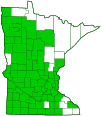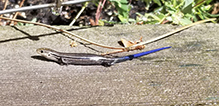Prairie skink
(Plestiodon septentrionalis)
Conservation • Description • Habitat • Biology • Distribution • Taxonomy
Conservation Status |
|
||||
| IUCN Red List | LC - Least Concern |
||||
| NatureServe | N5 - Secure S5 - Secure |
||||
| Minnesota | not listed |
||||
Description |
Prairie skink is a medium-sized, terrestrial lizard with a long tail. It is the most common skink in Minnesota. Adults are 5¼″ to 8¾″ in total length including the tail. Females may be larger than males. The body is shiny, tan or brown on the back, dark brown to almost black on the sides, with alternating dark and light stripes. There are three wide, pale stripes on the back that do not extend onto the head, and two very narrow white stripes on each side that do extend onto the head. The head is otherwise unmarked. The chin and throat are yellowish or pale yellow. The belly is gray to tan and unmarked. The legs are short, dark brown above, and pale below. The lips, chin, and throat of breeding males is bright orange during the breeding season. Juveniles have a bright blue tail that fades as the skink matures. |
Size |
5¼″ to 8¾″ long |
Similar Species |
Five-lined skink (Plestiodon fasciatus) dorsal stripe splits to form a Y shape on the top of the head. Juveniles and females have a blue or bluish-gray tail. Six-lined racerunner (Aspidoscelis sexlineatus) has three stripes on each side. |
Habitat |
Stream banks, openings in pine barrens, mixed grass prairies, oak savannas, rock outcroppings. Sandy soil. |
Biology |
Behavior |
|
Lifespan |
5 to 7 years |
Life Cycle |
When the temperature drops in September, skinks burrow into the ground to spend the winter. They are excellent diggers, burrowing up to 26″ deep to below the frost line. They spend the winter in a reduced metabolic state (brumation), similar to hibernation in mammals. They usually do not brumate in groups, each skink creating its own burrow. Adults emerge the following April. Juveniles emerge 3 to 4 weeks after adults. Breeding occurs in the spring. Sometime in June the female lays 4 to 18 eggs, usually 8 to 10, in a shallow nest under a surface cover. Northern prairie skinks reach sexual maturity in their third year. They live 5 to 7 years, possibly more. |
Food |
Grasshoppers, crickets, beetles, caterpillars, and other insects; also spiders, snails and and other small arthropods. |
Distribution |
||
|
Sources Biodiversity occurrence data published by: Minnesota Biodiversity Atlas (accessed through the Minnesota Biodiversity Atlas Portal, bellatlas.umn.edu, 6/14/2025). |
|
| 6/14/2025 | ||
Occurrence |
||
Common |
||
Taxonomy |
|
Class |
Reptilia (Reptiles) |
Superorder |
Lepidosauria |
Order |
Squamata (Snakes and Lizards) |
Suborder |
Lacertilia (lizards) |
Infraorder |
Scincomorpha (skinks, wall lizards, and relatives) |
Superfamily |
Scincoidea |
Family |
Scincidae (skinks) |
Subfamily |
Scincinae (typical skinks) |
Genus |
Plestiodon (toothy skinks) |
Prairie skink was formerly classified as Eumeces fasciatus. Recently, two separate studies, Smith (2005) and Brandley et al. (2005), proposed separating all species in North America north of Mexico into the genus Plestiodon. This was accepted by Crother (2008) and by Collins and Taggart (2009). Most sources now use this new classification. ITIS still classifies North American skinks in the genus Eumeces. |
|
Subordinate Taxa |
|
northern prairie skink (Plestiodon septentrionalis septentrionalis) pallid skink (Plestiodon septentrionalis pallidus) southern prairie skink (Plestiodon septentrionalis obtusirostris) |
|
Synonyms |
|
Eumeces obtusirostris Eumeces septentrionalis |
|
Common Names |
|
prairie skink |
|
Glossary
Brumation
Winter dormancy in reptiles. A cold-induced period of sluggishness, inactivity, and torpor in reptiles, akin to hibernation in mammals, but they stir occasionally to drink water.
Visitor Photos |
Share your photo of this reptile. |
||
This button not working for you? |
||
Joe B |
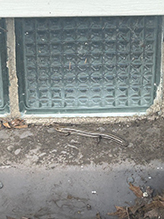 |
found him in the window well as I was cleaning out the leaves. Appears to have lost part of its tail |
Dan W. Andree |
||
 |
||
Northern Prairie Skink... This little skink was somewhat curious when I came across it. It would scoot around out of sight then back into view. Entertaining little character it was. |
||
Prairie Skink... I came across this little prairie skink out near Sandpiper Prairie SNA in Norman Co. Mn. It was probably 6-6.5 inches in length. Not very big I had previously seen a larger one some time back at a different location but that one was next to dense cover and scooted out of site. This one paused in the open briefly then scooted a distance, paused and scooted out of site. |
 |
|
Then I seen it again a little later. It was really windy Sept. 6th, 2020 up in this particular area. So taking photos or shooting video of it was difficult to say the least. But did somehow manage somewhat. I filmed this one going down a hole with just maybe an inch of its tail still sticking out then it backed out of the hole, paused briefly then it scooted off. Interesting and cute little lizard. |
||
Bahe |
 |
DT |
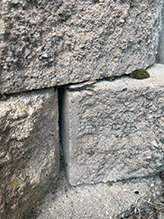 |
Mike B. |
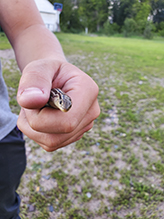 |
We saw several of these between 2020 and 2022 but haven't seen any of them this summer. |
Bill Reynolds |
||
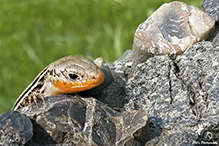 |
 |
|
Northern Prairie Skink This little male was sunbathing on a 2.7 million old Conglomerate stone in my backyard. As you can see this is just a head shot of him in mating colors. |
||
|
Here's a photo of a close up of a Northern Prairie Skink that I rescued from being mowed. | |
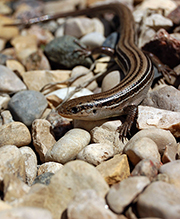 |
||
| Northern Prairie Skink |
|
|
Robin LaFortune |
||
Observed … skink at Lake Rebecca Reserve in Rockford Mn. Seen by one other observer. Had orange cheek patches and a shorter tail, as if a predator had grabbed the tail and the tail came off |
||
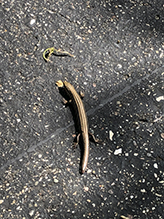 |
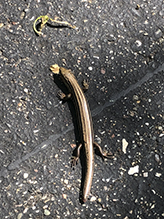 |
|
GLJ |
 |
James, Grant, and Aubrey Moldaschel |
||
Saw 2 juveniles with blue tail. Found by James (12) Grant (9) and Aubrey (6). They let it go after about a day and it still has it's tail. |
||
 |
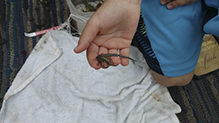 |
|
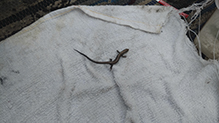 |
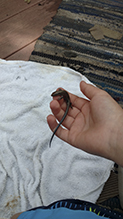 |
|
Christina |
 |
slithers like a snake and freaked me out. Never seen or heard of this before |
Bruce L. |
||
one of two seen today |
||
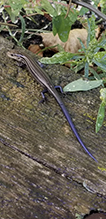 |
||
Jon R. Samuelson |
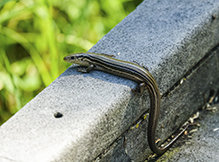 |
Mark DeBeer |
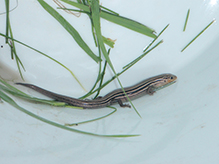 |
We live on an acreage that has quite a bit of loam soil but there is a gravel pit and wetland area nearby. |
Darren |
 |
This evening I rolled over a large rock and saw it curled up. |
MinnesotaSeasons.com Photos |
|

Slideshows |
|

Visitor Videos |
Share your video of this reptile. |
||
This button not working for you? |
||
Terry Eldien |
I found a RARE Lizard in Minnesota! |
About
The blue tailed skink. According to the Minnesotaseasons.com website they are only located in a few counties in Minnesota and are listed as "special concern". http://www.minnesotaseasons.com/Reptiles/prairie_skink.html I'm not sure how accurate their information is since the county that I find them in is not reported on their website. "Rare" might be a strong word to use but they are certainly uncommon and I would bet most people have never even heard of them let alone saw one in nature. Either way, they are a pretty cool creature to find in the wild! |
Other Videos |
Northern Prairie Skink in Minnesota Eumeces septentrionalis |
About
Uploaded on Sep 18, 2011 Eumeces septentrionalis Growing up, these things were all over our backyard. I took some video last time I was home. These guys are insanely fast. http://en.wikipedia.org/wiki/Prairie_Skink |
Iowa Northern Prairie Skink |
About
Published on Dec 16, 2012 The video was produced for the Mines of Spain exhibit area. It was taken with a Canon 7D and 100mm 2.8 macro lens. |

Visitor Sightings |
Report a sighting of this reptile. |
||
This button not working for you? |
||
Joe B |
Location: Royalton, MN found him in the window well as I was cleaning out the leaves. Appears to have lost part of its tail |
 |
| Janet 5/28/2025 |
Location: Swatara Mn I have a picture. Not sure how to include |
| Terry Eldien 7/30/2024 |
Location: Fergus Falls, Otter Tail County, MN These are common in my yard. |
DT |
Location: Hubbard County |
 |
Brice Mulholland |
Location: Merrifield, MN First one I've ever spotted on my own in 41 years! |
| Bill Reynolds 6/6/2022 |
Location: Pennington Co., MN Here's a photo of a close up of a Northern Prairie Skink that I rescued from being mowed. |
| GLJ 6/2/2022 |
Location: Pequot Lakes, MN |
Lindsey Mueller |
Location: Anoka, Mn non blue tail but moved so fast we couldn’t catch it! I have never seen one here before or anywhere in Minnesota living here my entire life (29 years!) they are like short garter snakes with legs in how they move around. |
| Mike B. 8/26/2020 |
Location: Sherburne County We saw several of these between 2020 and 2022 but haven't seen any of them this summer. |
 |
| Jeff n Wendi Iskierka 7/14/2020 |
.
Location: Shoreview, MN A juvenile … skink was found today in Shoreview, MN by my Wife. Blue tail, approx. 3-4 inches long. Climbed up on my wife's hands while pulling weeds from the block retaining wall. Expect a hatch happened so we put it back were found. Ramsey Co. |
| KBrek 7/13/2020 |
Location: Miltona, MN Not knowing what it was we grab it and ended up with just the tail. The tail kept moving for a few minutes after. |
DBox |
Location: Eagan, MN |
| Christina 9/6/2019 |
Location: Mound, MN: Dakota Trail slithers like a snake and freaked me out. Never seen or heard of this before |
 |
| Bruce L. 8/31/2019 |
Location: Island Lake, Hubbard County one of two seen today |
Carmen Stimac |
Location: Cottage Grove |
Steve Mosloff |
Location: ~ 7 miles SW of Thief River Falls, MN |
Justin Schroeder |
Location: North Branch |
Otto |
Location: Princeton, MN |
| Karl 8/14/2018 |
Location: Northern Minnesota just south of Bemidji. Northern Prairie Skink (Plestiodon septentrionalis septentrionalis) Fastest little lizard I’ve ever seen almost looked like a fast forwarded snake as it swam through the long grass I was mowing near our local dirt road..Very short legs almost like a salamander. A first time in the wild sighting for me. |
| Jon R. Samuelson 8/19/2017 |
Location: White Bear Lake |
 |
| GLJ 7/28/2016 |
Location: The Preserve Golf Course at Grand View Lodge, Pequot Lakes, MN We saw a juvenile with a bright blue tail at The Preserve just south of Pequot Lakes on Thursday July 28. Four of us saw it. We got a very close/good view of it. |
| Mark DeBeer 7/17/2015 |
Location: Russell, MN Lyon County We live on an acreage that has quite a bit of loam soil but there is a gravel pit and wetland area nearby. |
 |
Mindy |
Location: Elkton, SD |
Zeke |
Location: Lakeland, MN |
| Darren 5/23/2014 |
Location: St. Cloud, MN This evening I rolled over a large rock and saw it curled up. |
 |
Chris Savageau |
Location: Glyndon |
| Bill Reynolds 2010 |
Location: Pennington Co Minnesota Found in uncut field |
 |
MinnesotaSeasons.com Sightings |

|
Created: 10/8/2013 Last Updated: © MinnesotaSeasons.com. All rights reserved. |
